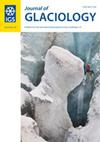Subglacial hydrology modeling predicts high winter water pressure and spatially variable transmissivity at Helheim Glacier, Greenland
IF 2.6
3区 地球科学
Q2 GEOGRAPHY, PHYSICAL
引用次数: 3
Abstract
Water pressure beneath glaciers influences ice velocity. Subglacial hydrology models are helpful for gaining insight into basal conditions, but models depend on unconstrained parameters, and a current challenge is reproducing elevated water pressures in winter. We eliminate terms related to englacial storage, opening by sliding, and melt due to changes in the pressure-melting-point temperature, to create a minimalist version of the Subglacial Hydrology And Kinetic, Transient Interactions (SHAKTI) model, and apply this model to Helheim Glacier in east Greenland to explore the winter base state of the subglacial drainage system. Our results suggest that meltwater produced at the bed alone supports active winter drainage with large areas of elevated water pressure and preferential drainage pathways, using a continuum approach that allows for transitions between flow regimes. Transmissivity varies spatially over several orders of magnitude from 10−4 to 103 m2s−1, with regions of weak transmissivity representing poorly connected regions of the system. Bed topography controls the location of primary drainage pathways, and high basal melt rates occur along the steep valley walls. Frictional heat from sliding is a dominant source of basal melt; different approaches for calculating basal shear stress produce significantly different basal melt rates and subglacial discharge.冰下水文模型预测格陵兰赫尔海姆冰川冬季高压和空间可变透射率
冰川下的水压影响冰的流速。冰下水文模型有助于深入了解基础条件,但模型依赖于不受约束的参数,目前的挑战是再现冬季升高的水压。我们消除了与冰川储存、滑动打开和压力熔点温度变化相关的术语,创建了极简版本的冰下水文和动力学、瞬态相互作用(SHAKTI)模型,并将该模型应用于格陵兰东部的Helheim冰川,以探索冰下排水系统的冬季基本状态。我们的研究结果表明,仅在床上产生的融水就可以通过大面积的高水压和优先的排水路径来支持冬季的主动排水,使用连续的方法,允许在流动状态之间转换。透射率在空间上从10−4到103 m2s−1变化了几个数量级,弱透射率的区域代表系统中连接不良的区域。河床地形控制着主要排水通道的位置,沿陡峭的山谷壁发生高基底融化速率。滑动摩擦热是基底熔体的主要热源;计算基底剪应力的不同方法会产生显著不同的基底融化速率和冰下流量。
本文章由计算机程序翻译,如有差异,请以英文原文为准。
求助全文
约1分钟内获得全文
求助全文
来源期刊

Journal of Glaciology
地学-地球科学综合
CiteScore
5.80
自引率
14.70%
发文量
101
审稿时长
6 months
期刊介绍:
Journal of Glaciology publishes original scientific articles and letters in any aspect of glaciology- the study of ice. Studies of natural, artificial, and extraterrestrial ice and snow, as well as interactions between ice, snow and the atmospheric, oceanic and subglacial environment are all eligible. They may be based on field work, remote sensing, laboratory investigations, theoretical analysis or numerical modelling, or may report on newly developed glaciological instruments. Subjects covered recently in the Journal have included palaeoclimatology and the chemistry of the atmosphere as revealed in ice cores; theoretical and applied physics and chemistry of ice; the dynamics of glaciers and ice sheets, and changes in their extent and mass under climatic forcing; glacier energy balances at all scales; glacial landforms, and glaciers as geomorphic agents; snow science in all its aspects; ice as a host for surface and subglacial ecosystems; sea ice, icebergs and lake ice; and avalanche dynamics and other glacial hazards to human activity. Studies of permafrost and of ice in the Earth’s atmosphere are also within the domain of the Journal, as are interdisciplinary applications to engineering, biological, and social sciences, and studies in the history of glaciology.
 求助内容:
求助内容: 应助结果提醒方式:
应助结果提醒方式:


